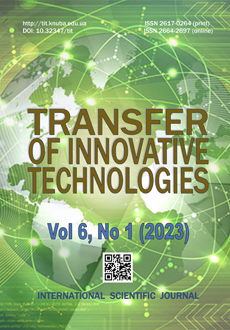System "dispersed polyvinyl acetate-calcium silicate" in furnishing materials
DOI:
https://doi.org/10.32347/tit.2023.61.0106Keywords:
calcium silicate hydrates, submicrocrystalline structure, dispersed polyvinyl acetate, polymer silicate phase, dispersed calcium silicate hydrateAbstract
This article focuses on the processes of interaction between calcium silicate hydrates and dispersed polyvinyl acetate in tight films with the aim of developing compounds meant for restoration and finishing works. The basis of this development relies on the concept concerning the determining role of the crystal-chemical factor of the silicate phase in the formation of organic-mineral compounds of increased durability. The characteristics of dispersed calcium silicate hydrates are portrayed. The preparation conditions, accounting for the synthesis of the product of submicrocrystalline structure, conforming with the stoichiometry CaO:SiO2=0.8-2.0 have been determined. The interaction has been studied for compounds achieved by mixing ingredients in a rapid whirling mixer, and subjected to hardening at T=20+2 °C. With the aid of XRD, DTA and Infra-Red Spectrometry methods the formation process of the sophisticated polymer silicate phase in the material was observed for a period of 90 days. The properties of the film were investigated and its high resistance against the influence of external factors was established. On this basis a conclusion concerning the quite high effectiveness of substituting portland cement with dispersed calcium silicate hydrate in polymer cement compounds has been made White colour and other various special properties determine the suitability for repair and finishing works on facades of buildings.
References
Kruglitsky, N. N., Boiko, G. P. (1981). Phisico-Chemical Mechanics of cementpolymer composition. Naukoba dumca, Kiev.
Von Schulz, H. W. (1975). Kunststoff und Beton. Kunstobbe, Nr.47, 604.
Tsapko Yu., Zavialov D., Bondarenko O., Marchenco N., Mazurchuk S., Horbachova O. (2019). Determination of thermal and physical characteristics of dead pine wood thermal insulation products, Eastern-European Journal of Enterprise Technologies. 4/10 (100), 37-43. DOI:10.15587/1729-4061.2019.175346.
Savchuk Y., Plugin A., Lyuty V., Pluhin O., Borziak O. (2018). Study of influence of the alkaline component on the physico-mechanical properties of the low clinker and clinkerless waterproof compositions. MATEC Web of Conferences 230, 03018.
doi:10.1051/matecconf/201823003018.
Glukhovsky V. D. etc. (1979). Alkali-activated and alkaline-alkaline-earth hydraulic binders and concretes. Vysha shkola, Kyiv.
Glukhovsky V. D. etc. (1981). Alkaline activated concretes on fine aggregates. Vyshcha shkola, Kyiv.
Runova R. F., Nosovskyi Yu. L., Dvorkin L. Y., Dvorkin О. L. (2012). Binders. Textbook. Osnova, Kyiv.
Chistyakov V. V., Grankovskii I. G., Gots V. I. (1986). Journal of applied chemistry, Nr. 59, 3 542–546.
H. Ye., Radlińska A. (2017). Effect of Alkalis on Cementitious Materials: Understanding the Relationship between Composition, Structure, and Volume Change Mechanism. Journal of Advanced Concrete Technology, Nr. 15(4), 165–177. doi: 10.3151/jact.15.165.
Rebinder P. А., Segalova Ye. Ye., Amelina Ya. А., Phisical-chemical foundations of binders hydration hardening. Paper presented at the VI international congress on cement chemistry, Book 1, Vol.2, 1976, 58–64.
Turba Y., Solodkyy S., Markiv T. (2020). Strength and Fracture Toughness of Cement Concrete, Dispersedly Reinforced by Combination of Polypropylene Fibers of Two Types. Lecture Notes in Civil Engineering 47, 488–494. doi: 10.1007/978-3-030-27011-7_62.
Rudenko I., Konstantynovskyi O., Kovalchuk A., Nikolainko M., Obremsky D. (2018). Efficiency of redispersible polymer powders in mortars for anchoring application based on alkali activated Portland cements. Key Engineering Materials, Switzerland, Nr. 761, 27–30. doi: 10.4028/www.scientific.net/KEM.761.27.
Kudina E. F., Pechersky G. G., Ermolovich O. A. (2012). Investigation of gel formation in systems of water grass polyakrylamid. Plastic Masses, Nr. 1, 27–29.
Bílek V., Pařízek L., Kosár P., Kratochvíl J., Kalina L. (2016). Materials Science Forum, Vol. 851, 45–50.
Pacheco-Torgal F., Barroso de Aguirre J., Ding Y., Tahri W., Baklouti S. (2015). Handbook of Alkali-activated Cements, Mortars and Concretes, 1st ed., 627–642.
Samchenko S. V. (2016). Formation and genesys of cement stone structure. NIU MGSU.
Gelevera А. G. (1986). PhD (Eng) thesis, Kyiv,.
Yang J., Wang Q., Zhou Y. (2017). Influence of Curing Time on the Drying Shrinkage of Concretes with Different Binders and Water-to-Binder Ratios. Advances in Materials Science and Engineering 2017, 1-10. doi: 10.1155/2017/2695435
Jia Z., Yang Y., Yang L., Zhang Y., Sun Z. (2018). Construction and Building Materials, 158, 198-207 doi: https://doi.org/10.1016/ j.conbuildmat.2017.09.162.
Downloads
Published
How to Cite
Issue
Section
License
Copyright (c) 2023 Yevgenia Petrikova, Natalia Amelina, Alla Maistrenko, Oksana Berdnyk

This work is licensed under a Creative Commons Attribution 4.0 International License.
Our journal abides by the CREATIVE COMMONS copyright rights and permissions for open access journals.
Authors, who are published in this journal, agree to the following conditions:
1. The authors reserve the right to authorship of the work and pass the first publication right of this work to the journal under the terms of a Creative Commons Attribution License, which allows others to freely distribute the published research with the obligatory reference to the authors of the original work and the first publication of the work in this journal.
2. The authors have the right to conclude separate supplement agreements that relate to non-exclusive work distribution in the form in which it has been published by the journal (for example, to upload the work to the online storage of the journal or publish it as part of a monograph), provided that the reference to the first publication of the work in this journal is included.




